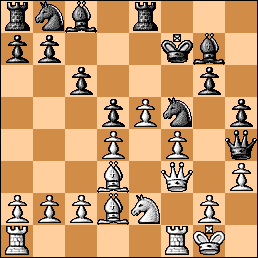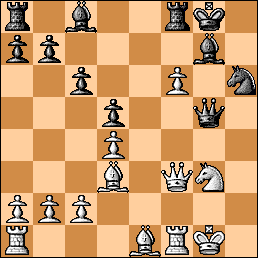I was always up for the experimental gambit here or there especially at free-wheeling New York City swisses.
Here’s the mighty anti-Petroff weapon, the Cochrane Gambit in action versus a Russian exaptriate, V. Goistroievich (the player formerly known as Polyakin).
This opening is named after John Cochrane, a British Scottish fellow barrister living in and around Calcutta in the 19th century and he tangled with the best Brahmin players of the day. IM Jay Whitehead has collected many Brahmin games in his 19th century database and I have privy to those files: many examples of modern-looking King’s Indians, Gruenfelds, and the like from the 1840’s to 1860’s! The very first Cochrane gambit was played by Cochrane against the Brahmin player Mohishunder in Calcutta, 1848.
A Brief Bio of John Cochrane
From John Henderson’s daily chess column in The Scotsman, 2 March 2007:
“He should not be forgotten. Scottish amateur and barrister John Cochrane (1798-1878), who died on this day 129 years ago, may not have achieved notoriety as a player, but he is responsible for perhaps the boldest opening innovation that survives unrefuted to this day.
Captain Evans deserves credit for his gambit, which influenced chess for years, but this was only the sacrifice of a mere pawn for obvious strong development. By contrast, it takes a remarkably brave, persistent, and swashbuckling player to take seriously the piece sacrifice in the normally staid Petroff’s Defence with 1 e4 e5 2 Nf3 Nf6 3 Nxe5 d6 4 Nxf7, and realize that rather than being a standard tyro’s silly attack that this is really a dangerous weapon.
Cochrane is also famously associated with the confusing naming history of the Scotch game. In the historic London vs. Edinburgh correspondence match of 1824-1828, Cochrane (though Scottish) played for London, and persuaded them to choose the then obscure opening he had been experimenting with.
In the middle of the first game, he had to leave for India; the English team squandered their opening advantage after he left, and went on to lose the game. The Scottish team were sufficiently impressed that they played the gambit successfully later in the match, and this led to its naming.
The debut though of his trademark 4 Nxf7 in the Petroff must have come as a shock to his opponent back in 1848, in much the same way as it stunned everyone when Topalov rehabilitated it against Kramnik, at Linares 1999.”
Onward and Upward: My Cochrane Game
M. Ginsburg – V. Gostroievich (2217) Petroff Defense, Cochrane Gambit CC January Open, 1/24/82, NYC. 30/90.
1. e4 e5 2. Nf3 Nf6 3. Nxe5 d6 4. Nxf7! The exclamation point is for the sheer audacity and for the fact this variation is underrated.
Position after 4. Nxf7! – white wants a pawn storm!
White’s idea is startlingly simple: he dislodges the black king and uses the extra pawns to make a united pawn storm. The missing knight is not of great consequence if the pawn storm can do damage. Everything hinges on the next few moves.
4…Kxf7 5. d4 This opening hinges on the primitive tactical trick that 5…Nxe4? 6. Qh5+, regaining the piece with an extra pawn, is not playable for black.
5…g6 (0:09) 5…Be7 is a bit passive. 6. Nc3 Re8 7. Bc4+ is clear compensation after either 7…Be6 or 7….Kf8. For example, 7…Be6 8. Bxe6+ (Taking the bishop is a tough choice because 8. d5 is interesting, too: 8…Bg4 9. f3 Bh5 10. e5!? Nfd7 11. e6+ with a complete mess) 8…Kxe6 9. O-O Kf7 10. f4. The immediate 5…Bg4 6. f3 doesn’t do anything, but black also has the direct 5…d5!?. After 6. e5 Ne4 7. Nd2 Nxd2 8. Bd2 Nc6 9. Qf3+ Kg8 10. c3 white retains compensation.
Readers will find the following sample variation humorous as well: 5….d5 6. e5 Ne4 7. Bd3!? Nc6 8. Be3 Be7 9. O-O Nb4 10. Be2 Bf5 11. g4 Bc8 12. f3 Ng5 13. a3 Nc6 14. Nc3 h5 (Chaos!) 15. h4 Nh3+ 16. Kg2 Bxh4 17. Qd3 Ng5 18. f4 Ne4 19. Nxe4 dxe4 20. Qxe4 Be6 21. c4 Bxg4 22. Bxg4 hxg4 23. d5 Ne7 24. f5 with a complete mess! A great Cochrane tableau.
The move chosen in this game, 5…g6, is somewhat slow and white can use the time to build up the menacing pawn front. These days, yet another try, 5….c5!? is considered critical. In Topalov-Kramnik, Linares 1999, White inverted the moves with 5. Nc3!? c5 6. d4, but this of course boils down to 5. d4.
6. Nc3 c6 Here, 6…Be6 is a major alternative. The direct 7. f4 d5 8. e5 Ne4 does not convince. There are humorous lines though, e.g. 9. Nxe4 dxe4 10. c4 c6 11. Be2 Bb4+ 12. Kf2 Nd7 13. d5 Bc5+ 14. Be3 Bxe3+ 15. Kxe3 (The King to the Attack!) 15…Qb6+ 16. Kxe4! (Excelsior!) with absurd complications after 16…Bf5+ 17. Kf3 Kg7 – black is somewhat better.
Stronger is 7. Bd3. We could get a weird Benoni with 7…c5 8. d5 Bg4 9. f3 Bd7 10. O-O and white’s compensation is evident.
7. f4 Bg7 8. e5 (0:05) White’s agenda is clear: Pawn-storm!
8…Re8 9. Bc4+! A fixed pawn structure helps white’s agenda.
9…d5 10. Bd3 Ng4 (0:46)
In the only other example I can find, Rodriguez played 10…Bg4!? here versus Alvarez Arandia in Asturias 1986. White played the feeble 11. Ne2? and after 11…Ne4 black was better and won the game eventually. However, 11. Qd2! is clearly stronger. After, e.g., 11…Nfd7 12. O-O white has obvious compensation. And the line 11. Qd2! Qb6? 12. Na4 Qd8 13. O-O Ne4 14. Bxe4 dxe4 15. f5! is just bad for black (15…gxf5 16. h3 and white is much better).
11. O-O Qh4 12. h3 Nh6 13. Qf3 Nf5 14. Ne2 h5 Black hurries to set up some kind of blockade but it all looks very flimsy. White simply directs more pieces to the kingside sector.
15. Bd2 (0:25)
Position after 15. Bd2. Black gaffes.
15…Kg8? (1:01) The computer correctly points out black needed to play something like 15…Rh8! or 15…Na6! here. Still, 15…Rh8 16. Be1 Qe7 17. g4 hxg4 18. hxg4 Nh4 19. Qg3 looks very nice for white. And on 15…Na6, the following crazy line is about equal: 15…Na6 16. Be1 Qe7 17. g4 hxg4 18. hxg4 Nh6 19. f5 Qg5! (not very easy to see in OTB) 20. fxg6+ double check Kg8 21. Qg2 Bxg4 22. Nf4 Nc5!! 23. dxc5 Bxe5 with equal chances! The onus is definitely on black to defend; white has pressure in most lines. After the gaffe in the game, it gets really bad, really fast.
16. Be1 Qd8 17. g4 hxg4 18. hxg4 Nh6 (1:05)
Position after 18…Nh6. Decision Time.
19. Bxg6? (0:42) A reciprocal blunder. Those with a very well tuned tactical intuition would spot the crushing 19. f5! gxf5 20. gxf5 Qg5+ 21. Ng3! Nd7 22. f6 Nxf6 23. exf6 Rf8
Position after 23…Rf8 (analysis)
Now white has a good continuation. 24. Qh5 Bxf6 25. Qxg5+ Bxg5 26. Bh7+! (A really nice point to justify all of this) Kxh7 (note that decling with 26…Kg7 27. Nh5+! does not help; an aesthetic geometrical arrangement) 27. Rxf8 Kg6 28. Ne2 Be7 29. Nf4+ Kg7 30. Ne6+ Kg6 31. Re8 Nf5 32. Nc7 Rb8 and white will win easily.
19… Bxg4 20. Qd3 Rf8 21. f5 (0:55) Bxf5? (1:14) Black tosses the game away in a state of sacrificial shock. He had to defend with 21… Nd7! 22. f6 Nxf6 23. Bh4 Bxe2 24. Qxe2 Qb6!! and this amazing resource saves the game, for example 25. exf6 Qxd4+ 26. Qf2 Qg4+ 27. Qg2 Qd4+ 28. Bf2 Qxf6 29. c3 Qd6 and black is fine.
22. Bxf5 Now white is completely winning. Chalk another up to Cochrane!
22…Qg5+ 23. Ng3 Na6 (1:20) 24. Bd2 (0:59) Qh4 25. Rf4 Qg5(?) Nominally a blunder but it didn’t matter.
26. Rg4 1-0
What do you think? Not a bad opening and worth a try!
I encourage readers to submit their own Cochrane material. And I just heard that GM Boris Alterman will be presenting it soon in an ICC Gambit lecture.
Postscript 2/19/08: Thanks to John Henderson for the Cochrane biographical material and the nationality correction!
Tags: 19th century chess, Brahmin, Cochrane Gambit, Gostroievich, Indian Chess, Jay Whitehead, John Henderson, Mohishunder




June 9, 2008 at 9:46 pm |
[…] is somewhat reminiscent of the Cochrane Gambit or the Halloween Gambit, where White sacrifices a piece for two pawns. It shouldn’t be sound, […]
December 31, 2008 at 3:23 pm |
i will try it. great
March 4, 2009 at 10:38 pm |
“The immediate 5…Bg4 6. f3 doesn’t do anything,” I’m not so sure. Does anyone have any games showing 5…Bg4 to be a bust?
August 26, 2010 at 10:52 am |
Here’s a fun win in the Cochrane I just played: http://bit.ly/a2W643
I don’t want to be a bummer, but you made a horrible blunder on move 5.
5. Bc4+? is a very weak move. it is refuted rather obviously by 5…d5. If 6. exd5 Qe8+! and ooops! You’re just a piece down. 7. Kf1 Bd6 and black has the initiative and an extra piece. It’s quite incredible that black in your game reacted with the bizarre 5…Ke7?? which is even weaker than the 5. Bc4+? lemon since 5….d5 is so clearly winning for black.
5. d4 is absolutely mandatory in the Cochrane.